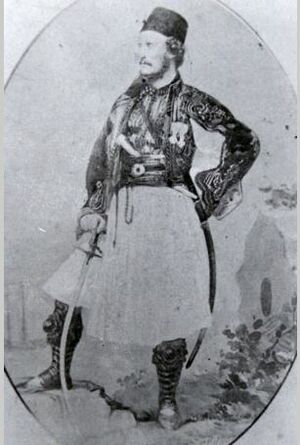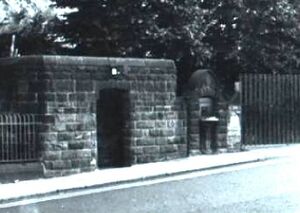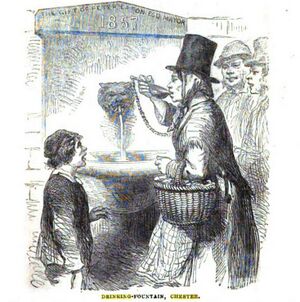Garston
Edgar Garston (1800-1873) was born and educated in Chester, According to his obituary in the Chester Courant 29 October 1873:
- "..his family carrying on the business of Wool merchants in Pepper Street, and residing at Watergate House, in Watergate Street, near the Watergate."
This presents something of a mystery given the history of that building, which was built in 1820 for Potts: checking on the 1841 Census his address is written as Watergate Place or Square. This was the square just outside the Watergate where large houses can be seen in early photographs. Nowadays Watergate Square is a small road near the entrance to the Roodee (on the former site of the Watergate Inn) and the site of his birthplace is a car-park.
Travels and Languages
In early life he travelled widely in Europe and Asia, becoming proficient in French, Italian, and Modern Greek. In 1820, his linguistic skills earned him a place as French interpreter for Queen Caroline's counsel during the divorce proceedings (from George IV) in the House of Lords (the Bill of Pains and Penalties), and he interpreted the testimony of Louisa Demont, the prosecution's chief witness.
Louisa Demont was a Swiss maid who had joined Caroline’s household in 1814 at Geneva. Demont has been described as somewhat of a social climber. According to Flora Fraser, she "worked her way up through a combination of allure, sly wit and, above all, an ability to please while pleasing herself" and Caroline treated her more as a friend than a maid. However, Demont’s relationship with Caroline soured, and in late 1817 she was dismissed along with a courier, Sacchini. Sacchini was dismissed for allegedly stealing from the Princess; Demont was thought to be an accomplice. She was also accused of falsely spreading a rumour that Caroline was in love with Sacchini. In the HOL trial, Demont proceeded to give detailed descriptions of the inappropriately close relationship between Caroline and Bartolomeo Pergami, the man at the centre of the adultery accusations. Her testimony was then ripped to shreds by the defence team.
He managed to obtain and translate Demont's Journal (1821), publishing first his translation and, a few days later, the original with T. and J. Allman. Since the journal contained Demont's loyalist sentiments before she had been allegedly suborned as a witness, the publication appears to have been part of a campaign to rehabilitate the Queen's reputation at Demont's expense. He is possibly in this painting.
Greece
In 1825-26 Garston witnessed the Greek Revolution first-hand and fought as a "Philhellene" volunteer, earning honours from the Greek government after the war. As recorded in the Courant:
- "On one occasion the intrepidity and coolness of Mr Garston when present at a desperate engagement turned what was likely to become a defeat into a great victory. When riding across the field of battle he met a portion of the Independent Party in full retreat. He upbraided them for their poltroonery, addressed a few inspiring words to them and drawing his sword placed himself at their head and led them back to battle which by their valorous fighting under the leadership of the English volunteer was turned into a great victory."
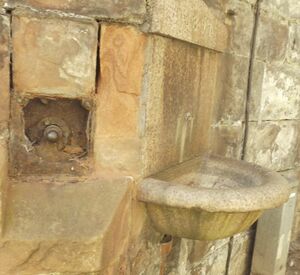
What the Courant fails to mention is that Garston recited a stirring passage of Homer in classical Greek to his hosts. The response was a question from one of the Greek fighters: “What language is that?”. The fighter probably spoke Romaioi.
In his later writing Garston notes how he had a chance encounter in Greece with an Englishman from Cheshire who he identifies as the "well known M----e". It is just possible that this was Thomas Leeke (Leche) Massie (20 October 1802 – 20 July 1898) who later lived at #3 Stanley Place and at the time was "the oldest known sailor of whom any record could be found", and hence generally known as "the father of the British Navy". Massie was born at Coddington Hall, Cheshire, and entered the navy in October 1818 as a midshipman on board HMS Rochfort, flagship in the Mediterranean of Sir Thomas Francis Fremantle (20 November 1765 – 19 December 1819: a good friend of Nelson), and later of Sir Graham Moore. Massie helped to smash the Turkish-Egyptian fleet at the battle of Navarino 1827 during the Greek War of Independence. Massie was also a member of the boat's crew sent ashore with the object of removing Lord Byron during his last illness. Byron had also gone to Greece as a Philhellene and died leading a campaign in 1824, at the age of 36, from a fever contracted after the first and second sieges of Missolonghi.
By his own account, Garston was also brought low by a fever (which he had contracted in Egypt) and forced to quit the country. At the end of the war the Greek Government, in recognition of the important service rendered to the cause of independence by Mr Garston, conferred upon him the illustrious order of K.R.G. of the Kingdom of Greece (Greek: Τάγμα του Σωτήρος, romanized: Tágma tou Sotíros). The English government of the day gave him permission to assume the title and wear the decorations of the order. The Courant stated: "but Mr Garston's modesty would not permit him to take advantage of this privilege" - which is not exactly true, it is on the cover of his book on Greece and he wore his insignia at his wedding.
Banking and Marriage
His name next appears in August 1830 on a list of Liverpool citizens published in the Liverpool Mercury soon after the July Revolution, sympathising with the French defenders of "Constitutional Rights", and thereafter his name is associated with charitable causes as a leading merchant and bank director of the Liverpool Union Bank in that city. The bank had a branch in Chester on the corner of City Road and Foregate Street.
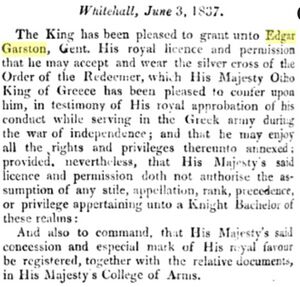
He toured Greece and Egypt in 1840 and published a partly retrospective account, "Greece Revisited and Sketches in Lower Egypt in 1840 with Thirty-Six Hours of a Campaign in Greece", in 1825 (1842).
In 1842 he married Mary Ann Isabella, née Grey (1821-1893), elder sister of the women's rights activist Josephine Butler (1828-1906; ODNB). In 1851 he joined the Chester Architectural, Archeological and Historic Society, presenting at least one paper on Greek archaeology. From 1867, he served as one of 3 men on the 12-member 'North of England Council for Promoting the Higher Education of Women' (NECPHEW) under the Presidency of his sister-in-law.
In later life, he continued to enjoy commercial success and to contribute to civic causes. He died at his residence, The Mount, Aigburth near Liverpool at the age of 74.
Drinking Fountains
Garston's relic in Chester is that he donated the drinking fountains which were once placed at the four gates of his native city and bore the following inscription :- "The gift of Edgar Garston K.S. 1857". Of the four fountains only that at Watergate remains, it is "dry", and the visible inscription now consists only of the date.
Public drinking water became a issue in the 1850's after John Snow identified the source of the 1854 Broad Street cholera outbreak in London. This was a part of the 1846-60 Cholera Pandemic. Snow famously removed the handle from the pump, the source for which had become contaminated by a broken sewer, but his work in developing more general theories of disease and epidemiology are often overlooked.
It appears that Chester was well ahead of other cities when it came to the provision of public drinking fountains, even the "Official Illustrated Guide" to the Great Western Railway mentions them stating:
- "We cannot quit Chester without alluding to the four drinking fountains erected at the expense of Peter Eaton Esq Mayor of the city. Our artist has given a sketch of one of these useful monuments of private liberality and good taste. Four additional fountains have been constructed by Edgar Garston Esq."
Curiously, the illustration in the Guide shows a fountain dated 1857, but with an inscription dedicated to Peter Eaton. Eaton was a brewer by trade. He was sheriff of Chester 1851/2 and mayor of Chester 1856/7. Eaton's fountains were apparently set up at the same time as Garston's and were made of granite from Aberdeen with bronze tiger heads issuing the water. In London the Metropolitan Drinking Fountain and Cattle Trough Association was set up in 1859, but the public fountain movement appears to have started in Liverpool in 1854 when cotton-merchant and philanthropist Charles Pierre Melly opened the first of his many drinking fountains, inspired by the examples he had seen in Geneva during a visit in 1852. Some early examples of Melly's fountains were in cast iron, and soon most in granite, having a standardised form very similar to that seen at Watergate. Nine of the Liverpool drinking fountains can still be seen there today. In a paper read to the National Association for the promotion of Social Science (1858) Melly reports that it was Garston (of Liverpool) who had the first fountains installed in Chester, followed by Eaton.
In Chester, "beating the bounds" was an opportunity for mayors to leave their mark on the landscape, by having boundary stones errected with their initials and the date. For example, there is a stone near the Duke's Drive at Heronbridge which bears the characters "PE M 1857" (see: Flookersbrook) . It is actually one of a whole string of such markers along the southern border of the city of which the 1911 OS map records fourteen such stones (about nine can still be found). The initials are probably those of P(eter) E(aton) M(ayor). He was also an Alderman of Chester in the 1860 directory. He started as a brewer near the Falcon, later he was a brewer in Northgate Street and also had a fire assurance business there as well. He is buried in Overleigh Cemetery (S2993). Eaton's Brewery eventually took over the Kelsterton and St. Winnifred's (Holywell) breweries and the company was bought out in 1864 by Henry Ford, Frederic Gunton and William Kelly, who formed the Northgate Brewing Company in 1889. They had 'bottling stores, wine and spirit vaults' at 7, Foregate Street and malt kilns on the east side of Lower Bridge Street (possibly at "Rotten Row") and owned pubs throughout Cheshire and North Wales. Eaton's name can be found scattered through the city records but it is his erection of a boundary marker which has secured his place in landscape history: his drinking fountains being largely forgotten.
The drinking fountains of Chester were reported in other media. In 1859 the London City Press reported on the "Metropolitan Drinking Association" of which the Marquis of Westminster was a member and quoted the costs for the installation of Eaton's fountains: £20 for the granite parts from Aberdeen, £5/13s for the tiger heads, £3/14s for carriage via Liverpool and £29/10s for installation. By 1866 however the fountains were already in a state of disrepair, with the Cheshire Observer of Feb 17th publishing a letter by "A looker on Bishopsfield" (somone from Hoole) which read:
- "To the Editor - In your last publication, a letter appeared signed 'Spectator' drawing attention to the state of the Chester drinking fountains. I fully coincide with his description of the utter dryness of many of the fountains and the others that do let a little water oose out and are so long in filling the small iron cup hanging at their side that people won't waste their time upon such useless things and prefer suffering thirst."
Many considered the fountains an antidote to drunkenness, when beer was the only other refreshment option, or water from horse troughs. Thus, the Temperance Movement got involved with the provision of drinking fountains. Many were placed opposite public houses. Some were quite elaborate and featured pious quotations or even depictions of the Greek mythical figure "Temperance". Typical quotations included variants on: "whosoever drinketh of this water shall thirst again but whosoever drinketh of the water I shall give him shall never thirst", a quote found on Jacobs Well at Chester, now in Grosvenor Park.
There is also a curious connection between cholera and drunkeness, as it was believed at the time of the cholera epidemic of 1831 that the "evils of intemperance" were a precursor to catching cholera. The Chester Chronicle noted "five sixths of all those of all those who fell in England by the disease were from the ranks of the intemperate and dissolute". Little regard was given to the fact that recourse to drink and a lack of unpolluted water were both associated with poverty.
Although John Snow had theorised that cholera was spread by what we now know as the "germ theory" this was not generally accepted until the 1860's. Nevertheless, it seems that the provision of pure drinking water was loosely associated with better health, as the council in Chester appears to have taken a sustained interest in the Water Supply after the cholera outbreak of 1849. The city council appointed a new water supply committee in 1852, with a brief which included considering taking over the water supply. In 1857 an Act raised additional capital and reconstituted the former water supplier as the Chester Waterworks Company. A constant supply was provided in stages from 1868: the whole town had water on Sunday mornings from 1871, and capital raised under the 1874 Chester Waterworks Act allowed the company to buy more efficient pumping engines from 1875 and meters to locate wastage in the mid 1880s. From 1887 the supply throughout the system was continuous.

The long-vanished "dolphin" drinking fountain at the bottom of Upper Bridge Street was donated to the City by a Mr Meadows Frost (a former Mayor, in 1858-59 and 1859-60), as a benefit both to horses and people. According to local records, the fountain was gifted to the city in 1860 by Mr Frost in remembrance of St Bridget's Church, which formerly occupied the space directly opposite St Michael's.

The location is interesting. Like most Roman settlements, Roman Chester had a large legionary bath complex for the soldiers to wash and to use for leisure time (the remains of which are in Bridge Street. It has been estimated that the baths used between 500,000 and 750,000 litres of water a day, which was supplied from the springs in Boughton. Water was piped in large lead pipes underground from a branch off the main aqueduct near the Eastgate, downhill to the baths on Bridge Street. The water was then held in large tanks with concrete foundations, and then fed through the complex. Waste water would have been fed downhill using gravity to the river - past this spot, where the Roman gate stood. In 1573 the then mayor, Richard Dutton, brought an unnamed workman from London to build a conduit from the Dee to the High Cross. By 1574 the plan had been altered: the corporation gave a contract to Peter Morris (or Maurice, possibly even Maurits) to excavate a spring at St. Giles's well in Spital Boughton (near St Giles Cemetery and known as "St Giles Spring") and convey the water in lead pipes to St Bridget's church - this very spot. The Bridge Street fountain is often said to have been removed during "road widening" (or more likely simply the intallation of a public loo) and spent its last days at Gorse Stacks. It was already described as in a "deplorably ruinous state" in 1902. Further mentions can be found in the local press:
- Chester Chronicle 1906: At a sub committee on December 4th plans were submitted for 1) an underground lavatory opposite the King's School in Northgate Street estimated cost £1523 and 2) an underground lavatory at the junction of Bridge Street and Grosvenor Street. The costs including the removal of the existing drinking fountain amounted to £609 and 3) the erection of lavatories on the Little Roodee adjoining the Grosvenor Road embankment, cost £822. The Improvement Committee recommended that 1 & 2 went ahead and an application be made to the Local Government board for sanction to borrow the sum of £2,200 for the purpose. The proposition regarding the King School site plan was amended to build the convenience nearer to the Town Hall.
- January 29th 1938 The Observer: The old public drinking fountains in Chester given by philanthropic citizens whose names they bear have long since fallen into dissuse with the advance of enlightened ideas of hygiene. Several of these were removed years ago and we wonder whether the other remaining fountains from which water no longer flows, are doomed to the same fate. One of the few remaining at the Northgate is now to disappear (Improvement Committee) This was the gift of Edgar Garston in 1857. There is one in George Street given by Peter Eaton, Mayor 1857. Another stands in Boughton given by Miss Humble in 1872.
Miss Humble's fountain at Boughton was in memory of her brother, and has been moved from its original location in the fork of the roads to be now against the cemetery wall. It is marked "Fn" on old maps from before 1914, as is the one in Bridge Street and another in George Street. The George Street fountain survived until at least 1972, as it appears in the crime-scene photographs of a notorious murder which took place close-by in that year. However it has since been removed by the widening of a car=park entrance.
The drinking fountain movement of the 1850's is now largely forgotten outside of London or perhaps also Liverpool. Edgar Garston's 1857 fountains at the four gates of the City are gone, save for the dry fountain at Watergate.
Sources and Links
Related Pages
- Watergate;
- Water Supply;
- Pandemic;
- Jacobs Well: another dry fountain moved to Grosvenor Park (which also contains Billy Hobby's Well);
- St Giles Cemetery: the site of another drinking fountain;
Online
- Charles Pierre Melly;
- The Grey family of Milfield Hill, Northumberland;
- Illustrated London News: on drinking fountains in London, Chester and Liverpool;
- The Lancet: drinking fountains in Chester;
- A Paper on Drinking Fountains: by Melly;
